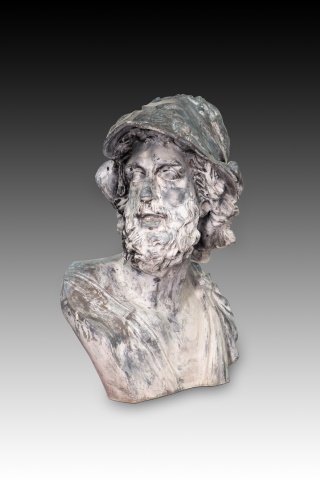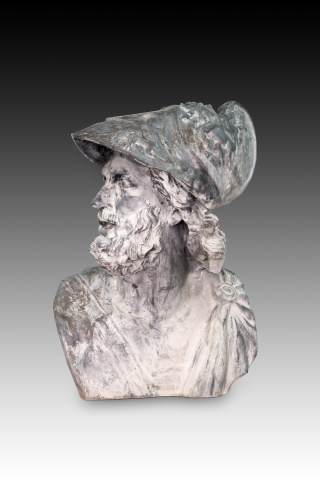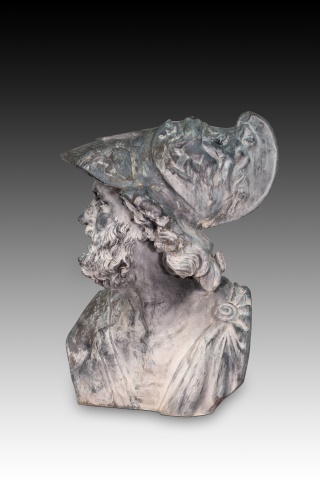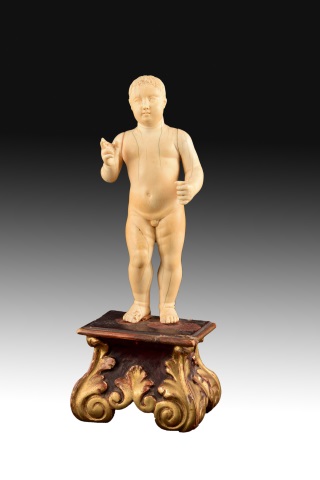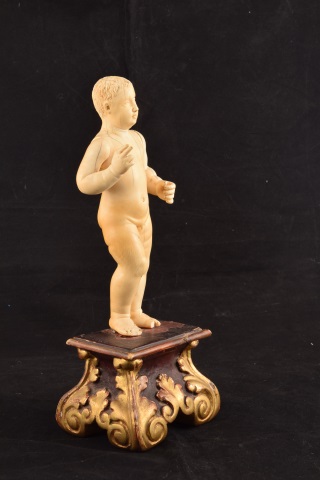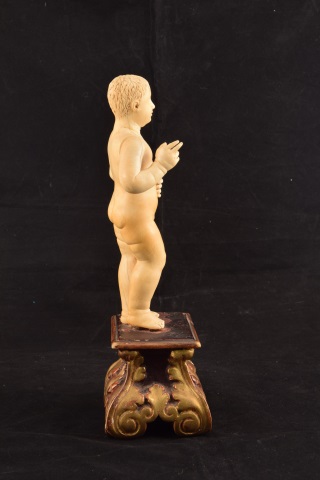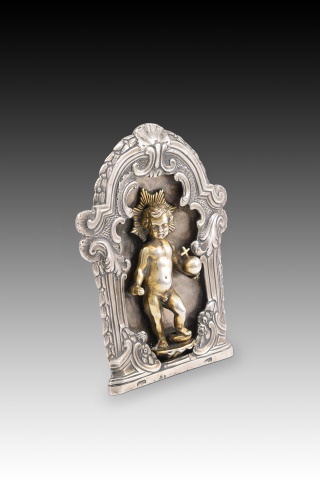
-
SAINT DREAMING. POLYCHROMED WOOD. FLEMISH SCHOOL, 16TH CENTURY.
Dream of a Saint. Carved and polychrome wood. Flemish school, 16th century. Relief made of carved and polychrome wood showing an old man with a particular headdress (reminiscent of some chaperones) lying on a bed and accompanied by two friars dressed in habits, who are talking to each other. Iconographically, the figure of the old man lying in bed (note the cushion that raises the upper part of the body, following the usual use at the time) who has not died (probably) because he is not completely lying down, is reminiscent of how, for example, Saint Anthony, Saint Jerome, etc. were usually represented. It is not very likely that it is the subject of the Transit or Death of Saint Francis of Assisi due to the absence of the Stigmata and his age. It would have been part of a cycle of scenes on the altarpiece of some church, an accompaniment that would give the spectator more clues about the identity of those represented. Stylistically, Flemish sculpture, along with that of the Germanic countries, developed with a realism that could be appreciated in all the ornamental details, where the sculptural work was presented almost as a goldsmith's work that was applied to the large altars made of wood. In general, in the Netherlands, such a high level had been developed during the Gothic period that the acceptance of the Renaissance from Italy was late. Weight: 3 kg.ANTIQUES
· Size: 36x6x36,5 cms.
Ref.: ZF1174 -
BUST OF MENELAUS OR AJAX (PASQUIN GROUP). BRONZE. 20TH CENTURY.
Bust of Menelaus or Ajax (Pasquino Group). Bronze. 20th century. Bust made of bronze showing a bearded man, dressed in a cloak gathered with a circular brooch and with a strip on the other shoulder, and wearing a helmet decorated with reliefs. The work is inspired by a highly prized sculpture known as the Pasquino Group (or Menelaus Carrying the Body of Patroclus or Ajax Carrying the Body of Achilles), made in marble copying a Hellenistic bronze and dated to around 200-150 BC. About fifteen Roman marble copies are known of it, many of which were “intervened” (or restored) during the 16th and 17th centuries. The earliest of these copies were documented for the first time in Rome in 1500. Cosimo I, Grand Duke of Tuscany, bought an ancient marble fragment of an armoured male bust supporting a dying companion, brought it to Florence (inventoried in 1574) and Ferdinando II commissioned its “restoration” (or rather intervention) to Lodovico Salvetti based on a model by Pietro Tacca, giving rise to the so-called “Menelaus Holding the Body of Patroclus” in the Loggia dei Lanzi in Florence (Italy). In 1771, Anton Raphael Mengs (Aussig, Bohemia, 12 March 1728 – Rome, 29 June 1779) took moulds of the parts he considered ancient (original) of this group and of the one in the Palazzo Pitti (a gift from Paolo Antonino Soderini in 1570), and assembled them into a plaster model that he intended to be more faithful to the Roman original. After a series of changes, it was rebuilt in 1838 and exhibited in the Loggia dei Lanzi in the Piazza della Signoria in Florence. This work by Mengs is cited to compare this bust with others inspired by those made by the neoclassical artist: Unknown creator, Head of Ajax from the Palazzo Pitti, c. 1770. Plaster cast. Dresden, Skulpturensammlung (ASN 1932); Head of Menelaus, Pushkin Museum, Moscow, etc. It should also be noted that many of these (for example, those mentioned in Dresden) are casts of a bust from the period of Hadrian of a head of Achilles originally Hellenistic which is in the Vatican Museums in Rome (inv. 694) and is also considered part of the Pasquino Group. We must emphasize the comparison of this bronze bust with this marble sculpture. Weight: 110 kg.ANTIQUES
· Size: 82x55x116 cms.
Ref.: ZF1236 -
VIRGIN OF CARMEL (DRESSED UP). WOOD, METAL AND TEXTILE. SPANISH SCHOOL...
Virgin of Carmen dressed. Wood, metal and textile. Spanish school of the 19th century. Virgin of Carmen carved in wood and polychrome, an image of richly dressed with a tunic embroidered in gold with a white lace collar, a white cloak with gold thread lace in the profile and a delicate veil over the head, also white. The Child, who is held in her left arm, wears a white shirt with a lace collar and cuffs and a brown tunic also embroidered and finished in gold thread, with a cord at the waist of the same material. The gold lace that adorns Mary's cloak represents scallops, in allusion to the marine character of the Virgin of Carmen. Mary holds the scapular with her right hand, and wears long earrings of gold and silver thread and a royal crown openwork and decorated with rays and stars, in metal. The Child also appears adorned with a radial metal crown, simpler than that of his mother. The carving balances naturalism and idealisation, and shows a typically 19th-century delicacy and sweetness that is enhanced by the subtle polychromy, with light, evanescent tones, highly nuanced by glazes. The eyes of both figures are made of glass, a common element in 19th-century Spanish images of clothing that adds liveliness to the images. The ensemble stands on a pedestal of clouds polychromed using the estofado technique, supported by a stylised architectural design foot with a marble plinth simulated by polychromy. Weight: 5.5 kg.ANTIQUES
· Size: 42x27x116 cms
Ref.: ZF1249 -
VIRGIN WOMAN WITH CHILD, 17TH TO 18TH CENTURIES
Spanish school of the late 17th century – early 18th century. “Virgin and Child”. Carved and polychrome wood. Devotional image carved in wood in the round and polychrome, framed within the late Spanish Baroque. It is a sculpture of monumental conception, with large and monolithic figures, with volumes enhanced through the ample folds of Mary's tunic. The Virgin appears standing, holding the Child on her lap, in a naturalistic position, full of movement. Thus, we see how Mary, to compensate for the weight of the Child, leans her back backwards, while Jesus leans forwards in turn, thus compensating the composition. The Child appears raising his right hand in a sign of blessing, while the other hand rests on a sphere, a symbol of the universality of Christian doctrine and of Christ's redemptive act. Spanish Baroque sculpture is one of the most authentic and personal examples of our art, because its conception and its form of expression arose from the people and from the deepest feelings that nestled within them. With the State's economy in ruins, the nobility in decline and the high clergy burdened with heavy taxes, it was the monasteries, parishes and brotherhoods of clergy and lay people that promoted its development, the works being financed on occasion by popular subscription. Sculpture was thus forced to express the ideals that prevailed in these environments, which were none other than religious ones, at a time when the counter-reformist doctrine demanded from art a realistic language so that the faithful could understand and identify with what was represented, and an expression endowed with intense emotional content to increase the fervour and devotion of the people. Religious subject matter is, therefore, the preferred theme of Spanish sculpture in this period, which began in the first decades of the century with a priority interest in capturing nature, to progressively intensify throughout the century the embodiment of expressive values, which was achieved through movement and the variety of gestures, the use of light resources and the representation of moods and feelings.ANTIQUES
· Size: 32x26x70 cms.
SCULPTURERef.: Z2514 -
CHILD JESUS. IVORY, WOOD. 18TH CENTURY.
Infant Jesus. Ivory and polychrome wood. 18th century. Ivory carving of the Infant Jesus, standing and naked, raising one of his arms in a gesture of blessing and placed on a pedestal or base of carved, polychrome and gilded wood decorated with plant elements in the corners with a certain Baroque feel. It has a CITES certificate. Valid for the European UnionANTIQUES
· Size: 12x9x30 cms. Niño 9x6x22 cms.
Ref.: ZF0756 -
POLYCHROMED AND “ESTOFADA” WOODEN SCULPTURE. “LUKE THE EVANGELIST”. 16...
Polychrome and upholstered wood carving. “Saint Luke the Evangelist”. 16th century. Freestanding devotional figure of a bearded man standing with one knee raised to support a tablet on which he is writing. Beneath his left leg, a bull is looking towards him, lying on the ground. The clothing reveals the gold base that forms the stew. Saint Luke is frequently represented as a middle-aged, bearded man, accompanied by the Tetramorph animal with which he is associated (Revelation 4:6-7), an element that is also due to a verse in the Book of Ezekiel (1:10). The act of writing alludes to his authorship of one of the Gospels, although the Acts of the Apostles are also attributed to him. The image belonged to an altarpiece, hence the back part is barely worked and polychrome, and it was placed alone or as part of a scene such as a Last Judgement. Stylistically, the image's upholstery and its design are details that remain from the Gothic tradition. However, the correct anatomy of the figure, the contained movement conveyed by the drapes and its posture, and the naturalism and expression of its face relate the work to the Renaissance. In Spain, this artistic style was introduced during the 16th century, with great differences depending on the region and artist. After an initial stage in which strong medieval influences were still present, the second third of the century saw the introduction of Mannerism by artists who had travelled to Italy and returned with the novelties. It is with this second stage that the sculpture is most closely related, without forgetting the medieval details that it still maintains and the restraint of its movement and expressiveness. Compare, for example, with the works of Alonso de Berruguete and Juan de Juni, the evangelists Saint Luke and Saint Mark from the church of Santa Eulalia de Ganuza, today in the Diocesan Museum of Pamplona. Requires cleaning and polychrome restoration.ANTIQUES
· Size: 16x7x36 cms,
SCULPTURERef.: Z6546 -
GILDED BRONZE PROCESSIONAL CROSS TOP. 20TH CENTURY, AFTER EARLIER MODE...
Processional cross finial. Gilt bronze. 20th century. Latin cross with straight arms decorated with tabs between mouldings on both fronts, rays at the intersection of the arms, and multi-lobed finials reminiscent of fleur-de-lis decorated with flowers and palmettes at the ends; on the obverse, Christ crucified with a halo of rays and a loincloth; on the reverse, the Virgin Mary with a halo, standing in an attitude of prayer. Knot composed of various elements (mouldings of different radii, etc.) among which a circular central body stands out, enhanced with small cresting and reliefs with the four Evangelists accompanied by their element of the Tetramorph and situated in landscapes. As can be seen in various elements, the piece is inspired by styles of the past.ANTIQUES
· Size: 56x36x108 cms
Ref.: ZF0612 -
SAINT PAUL\'S SCULPTURE. 16TH CENTURY
Spanish school of the 16th century. "Saint Paul". Carved and polychrome wood. A devotional image carved in wood, polychrome and gilded, representing the apostle Saint Paul, dressed in a tunic and cloak, with a parted beard, brown hair and a large sword, his main iconographic attribute. In the Middle Ages, numerous corporations were placed under his patronage, due to different aspects of his iconography, life and miracles. However, Saint Paul was never a popular saint, which proves the relative poverty of his iconography. In fact, the role he occupies in art is not proportional to his importance in the spread of Christianity. In early Christian art, his only attributes are a book or a scroll, and in the 13th century his emblem appears, the sword that was the instrument of his martyrdom. Once the clash between tradition and modernity was overcome, with the arrival of the influences of the Italian Renaissance in Spain, the full 16th century was characterised by the great development achieved by religious imagery. Likewise, stylistically there was a confrontation between the classicist sculptors and those of Flemish affiliation, who sought more dramatic and emotional approaches. Thus, the spread of religious images in Spain was based on two fundamental bases. On the one hand, the fact that the Nordic influence constituted a clearly differentiated alternative to the Italian classicist model; on the other, the emotional sense, which the religious image had to acquire due to its own function, was oriented more towards enhancing the feeling, to moving the faithful, than to following the rationalist dictates of the Renaissance. So much so that in Spain, attention to the emotional had a more relevant character than in the rest of Europe. In this way the image, associated with the words of the preachers, was the most suitable instrument for the indoctrination of the people and for the defense of the canons of the Church, following scholastic and not humanistic approaches.ANTIQUES
· Size: 19x12x39 cms.
SCULPTURERef.: Z3024 -
CROWN OR CREST. PINEWOOD. 17TH CENTURY.
Finial. Carved pine wood. 17th century. A finial or crest made of pine wood carved in its colour with a human bust in the centre, placed holding two volutes and thus creating an axis of symmetry for the elaborate composition that the piece presents, based on flowers, plant motifs, architectural details, etc. with a certain classicist influence and a lot of movement and depth. The fact that the back is unworked suggests that this relief may have originally been part of an important altarpiece, given the size and quality of the piece. Both the movement and the decorative elements of the composition link the work to the Spanish Baroque.ANTIQUES
· Size: 117x65x45 cms
Ref.: ZF0499 -
VIRGIN MARY OR SAINT (TO DRESS UP). WOOD, METAL. SPANISH SCHOOL, 17TH ...
Saint or Virgin of dress. Wood, metal. Spanish school, 17th century. It has faults. The female figure is standing (with her right leg forward) on a small polygonal base. Made of partially polychrome wood, note the elaborate work on the feet (which peek out from the “dress”), the hands up to the wrists, and the head and neck. The skull is prepared to receive hairpieces or clothing. As for the carvings of clothing, these were very common during the Spanish Baroque, and there may be cases of works in which the unseen part was barely roughed out and others in which the entire carving is found, with many intermediate points (see the present case). Remember the San Antonio Abad by Benito Silveira made in the second half of the 18th century that is in the National Museum of Sculpture in Valladolid, a San Francisco de Paula from the 18th century in the Museo del Carmen in Maipú (Santiago de Chile), etc.ANTIQUES
· Size: 33x25x87 cms
Ref.: ZF1181 -
PAIR OF CARVED WOOD BRACKETS. VENICE, 19TH CENTURY.
Pair of carved wooden corbels. Venice, 19th century. Pair of 19th century figurative corbels, carved in round wood, with a beautiful dark patina that enhances the relief and details of the sculptural work. They are signed on the back “Felici Venezia”. The lintels, with a moulded profile and a Baroque plan, with numerous recesses and projections, rise above two vegetal herms in the classical style, with the lower part in the form of a brace decorated with large acanthus leaves worked with a soft, gentle-looking carving, which moves away from the general classical inspiration to approach the naturalism of Art Nouveau. From these braces emerge the busts of two winged cupids, children's bodies carved in the round with grace and attention to detail, with a delicate dynamism. The two putti are represented in the same position, with one arm bent over their chest and the other raised above their head. They form a symmetrical composition, each a mirror image of the other. The high quality of the carving of these pieces is particularly appreciated in these figurative representations: the anatomical work is impeccable, as is the expressiveness of the faces, and the carving of the wings, hair and ribbons that adorn their torsos reflects meticulous, naturalistic and precious work in detail.ANTIQUES
· Size: 25x15x48 cms.
Ref.: ZF1229 -
CROWN. POLYCHROMED WOOD. 18TH CENTURY.
Finial. Carved and polychrome wood. 18th century. Carved, polychrome and gilded wooden finial decorated with a light relief based on lying "C" volutes joined in pairs at one end and plant elements arranged in a rigid symmetrical composition with a clear classicist influence with movement of lines and a volume that is not too pronounced.ANTIQUES
· Size: 145x10x68 cms.
Ref.: Z4926 -
FIGURE FOR HOLDING A CANDLE. POLYCHROMED WOOD, WROUGHT IRON. CASTILLIA...
Torch-bearing figure. Carved and polychrome wood, wrought iron. Castilian school, 16th-17th centuries. A carved and polychrome wooden sculpture placed on a simple base showing a half-naked male figure, holding in his hands a cloth that covers the lower part of his body in front and holding up a wrought iron cone intended to hold a candle. The nude, the study of anatomy, the contrapposto and the twist of the torso and waist of the figure are details that would speak of a classicist influence in the sculpture. It is also worth highlighting the movement that the posture brings to the piece, placing one foot behind the other and turned with respect to it and slightly turning the waist. Wood was the most worked material in Spanish Renaissance sculpture, normally with a polychrome finish and with gilding and upholstery. It was not until the second third of the 16th century when sculptors emerged in Spain who reached great heights in the Spanish Renaissance, inspired by Italian forms, but adding their own national touch, creating different schools, and with a clear preference for polychrome and upholstery wood. At this time, one of the main workshops was Valladolid, with names such as Alonso Berruguete and Juan de Juni. Later, art evolved towards a classicist or Romanist mannerism, with a significant influence from Italian masters, with a clear influence from Michelangelo and names such as Gaspar Becerra, Esteban Jordán, Juan de Ancheta, etc.ANTIQUES
· Size: 18x18x48 cms.
Ref.: ZF0461 -
VIRGIN MARY (TO DRESS UP). WOOD, METAL. SPANISH SCHOOL, 17TH CENTURY.
Virgin of Dressing. Wood, metal. Spanish school, 17th century. It has faults (hand, etc.). Sculpture made of polychrome wood showing a woman, with the head, neck and hands carved and polychrome in detail, a sketched dress and arms in exposed wood. Iconographically, it is probably a Virgin Mary, made in this way because it was designed to be dressed and adorned with hairpieces (hence the work on the skull area). It is worth highlighting the folds on the front, not common in this type of work, resembling clothing. It has a closed royal crown. Dress carvings were very common during the Spanish Baroque, and there may be cases of works in which the unseen part was barely roughed out and others in which the entire carving is found, with many intermediate points (see the present case). Remember the San Antonio Abad by Benito Silveira made in the second half of the 18th century that is in the National Museum of Sculpture in Valladolid, a San Francisco de Paula from the 18th century in the Museo del Carmen in Maipú (Santiago de Chile), etc.ANTIQUES
· Size: 44x28x86 cms
Ref.: ZF1182 -
SAINT JOHN THE BAPTIST. POLYCHROMED BOXWOOD. 17TH CENTURY.
“San Juan”. Carved and polychrome boxwood. 17th century. Standing on a simple base is the figure of Saint John the Baptist, partially dressed in a red tunic that reveals his anatomy by showing part of his body and identified by the lamb that accompanies him (in the Bible, Jesus is called “the Lamb of God,” hence this animal is one of his most common iconographic attributes). Stylistically, and to appreciate the stylistic differences, compare it with the Saint John the Baptist of the “Retablo de San Juan Bautista” by Juan de Juni and Inocencio Berruguete, dated 1551 and today in the National Museum of Sculpture in Valladolid, or with the carving of the same subject by Alonso Cano (commissioned in 1634) and which is in the same museum. It is also necessary to mention works such as that of Juan de Ávila from the Oratory of San Felipe Neri in Valladolid (today in the Diocesan and Cathedral Museum of Valladolid; dated 1699) or the carving by Juan de Mesa that is in the Museum of Fine Arts in Seville.ANTIQUES
· Size: 11,5x7x31 cms.
SCULPTURERef.: Z5790 -
PORCELAIN CENTREPIECE. VOLKSTEDT, RUDOLSTADT, GERMANY. CA END 19TH CEN...
Centerpiece. Volkstedt, Rudolstadt, Germany. Towards the end of the 19th century. Glazed porcelain. A circular centrepiece raised on simple legs, displaying a delicate multi-level composition. The children are arranged using a large stone and a tree trunk, with one child on top wearing a purple band holding flowers; below, there are four others, also half-naked, holding glasses, flowers, etc. Both the figures and the composition show a clear influence of Neoclassical models. This same relationship explains the theme: it is a series of figures linked to classical mythology, dealing with a pleasant and secondary theme (only a slight relationship with a bacchanal can be intuited by a cup that is presented), highly appreciated for the rich interiors of the period for maintaining the decorum required at the time. The factory's signature is clearly visible at the bottom in the centre and is in blue tones, with a signature (Marion) "engraved" below it. The Volkstedt factory, located in Rudolstadt (Thuringia, Germany), was founded at the official request of Georg Heinrich Macheleid in 1760, who had worked at the Glücksthal glassworks and had allegedly developed the porcelain formula on his own, without any contact with the Meissen ceramists Ehrenfried Walther von Tschirnhaus and Johann Friedrick Böttger. The privilege was granted in 1762 by Johann Friederich (Prince of Schwarzburg-Rudolstadt), specifying that it be established at that point, close to his court and under his personal direction. After several changes of hands over the years, it remains in force today.ANTIQUES
· Size: 34x34x56cms.
Ref.: ZF0144 -
GOLDEN PHEASANT. POLYCHROMED BRONZE. VIENNA, 19TH CENTURY.
Golden pheasant. Polychrome bronze. Vienna, 19th century. Polychrome bronze figure depicting a perched male golden pheasant. A bird originally from Asia, it was already known in the West in the 18th century (it appears in the tenth edition of Linnaeus' Systema Naturae) and appreciated for the bright colours of the male's plumage. In the 19th century, Vienna (and other European centres) produced bronze centrepieces and decorative figures of great originality and quality, usually with an exotic touch provided by anthropomorphic or animal motifs. Weight: 991 grams.ANTIQUES
· Size: 33x9x17,5 cms.
Ref.: ZE262 -
BASE FOR SCULPTURE. POLYCHROMED AND GILDED WOOD.
Scallop base. Carved and polychrome wood. Inspired by 17th century models. Rectangular pedestal with a similar cushion on the top (decorated with plant elements) and complex lines of curves and counter-curves enhanced with architectural elements, including “C” volutes arranged in pairs on each side. At the bottom, the corner claws and the cut-out lower profile are noteworthy. Weight: 3.85 kg.ANTIQUES
· Size: 42x33x24 cms.
Ref.: ZE370 -
BITE. BRONZE, MARBLE. FRANCE, CIRCA LATE 19TH CENTURY.
Grip. Blued bronze, marble. France, late 19th century. A sculpture in burnished bronze on an oval base in green-veined marble showing two lionesses or two panthers engaged in a fight, one biting the other's neck and both with their claws, limbs and muscles tense. It is worth highlighting the quality of the design and composition as well as the modelling and casting, as a series of striking details can be clearly seen in the work. On the base, engraved, there is an inscription linked to Clovis-Edmond Masson (Paris, France, 1838-1913). Trained with Antoine-Louis Barye, Rouillard and Santiago, he regularly showed his work (mainly on animal themes and almost always using bronze, wax or plaster) at the Paris Salon between 1867 and 1909. Thanks to the popularity and quality of his work, numerous bronze figures were made for the interiors of prominent residences. Currently, the most valued works are those of felines in violent attitudes and postures or showing strength, which seem to anticipate what was usual in this type of art in France between 1910 and 1930.ANTIQUES
· Size: 65x23x38 cms.
Ref.: ZF0930 -
COLUMN. POLYCHROMED AND GILDED WOOD. 16TH CENTURY
Column. Carved, polychrome and gilded wood. 16th century. Carved and polychrome wooden column with a capital reminiscent of the Composite Order of Classical Antiquity (volutes, acanthus leaves in levels, etc.), a series of mouldings separating the shaft from the rest of the elements, a fluted shaft with a strip at the bottom with figurative elements and latticework, and a base with prominent upward-facing volutes and smooth mouldings at the corners. The aforementioned frieze shows a series of figures with only cloth hangings behind them as the background and carrying a series of elements (flowers, one with a tower with three windows that could be linked to Saint Barbara, etc.). In some details it is reminiscent of columns from other notable works such as the High Altarpiece of Our Lady of the Assumption of Tudela de Duero in Valladolid (last quarter of the 16th century-early 17th century, with designs by Manuel Álvarez and Francisco de la Maza); the High Altarpiece of the Cathedral of Astorga (1558-1584, following the architectural designs of Gaspar Becerra) has fluted columns with the lower part decorated with figurative reliefs; this detail is also present in the altarpiece of the Virgin Mary of Corcos del Valle (last quarter of the 16th century); etc.ANTIQUES
· Size: 28x28x90 cms
Ref.: ZE239 -
BRONZE “WOUNDED FIGHTING BULL”.
Bronze sculpture, “Wounded Bull”. Signed “F. Bonilla Villalba” on the base. On a wooden pedestal, the figure of a bull is placed after the banderillas and death stages, as the elements used in both can be seen: three banderillas and the estoque. Thanks to the great quality of the artist, one can see both the moment when the bull is about to expire and bellows as well as the blood that flows from its wounds. The drama is accentuated thanks to the particular treatment of the animal's skin.ANTIQUES
· Size: 55x27x40 cms.
SCULPTURERef.: Z6180 -
PAX WITH INFANT JESUS AS SALVATOR MUNDI. PARTIALLY GILT SILVER AND PEA...
Peace-bearer with the Child Jesus as Salvator Mundi. Partially gilded silver and a pearl. Madrid, 1781. A peace-bearer with a structure in silver in its colour, embossed and chiselled, and a round figure of the Child Jesus cast and gilded. The Child appears naked, with a radiant halo and resting his left leg on a rock, in a contrapposto position of classical heritage. He is represented as Salvator Mundi, with a sphere that symbolises the world in his left hand, crowned by the cross. The Salvator Mundi is usually shown blessing with his right hand, a gesture that is eliminated here to make the Child hold a sceptre of command topped with a pearl. The figure sits on a corbel in the shape of a scallop and is situated within a niche topped with a semicircular arch, with another scallop at its apex, in allusion to the sacrament of baptism. The profile of the niche shows a fantastic architectural design, with C-shaped braces, floral elements, thick acanthus leaves, rows of bells and rocaille crests. In the upper area, the bottom of the arch appears worked with small incisions that shade the surface, highlighting the relief of the rest of the elements. The flat back has a support band also in silver, joined by soldering. The piece has hallmarks of Madrid Villa y Corte from 1781. Illegible silversmith's mark.ANTIQUES
· Size: 11x6x13,5 cms
Ref.: ZF1251 -
PAIR OF RELIEFS; GROTESQUE OR CANDELIERI. POLICHROMED AND GILDED WOOD....
Pair of reliefs; grotesques or candelieri. Carved, polychrome and gilded wood. 16th century. Pair of reliefs made of hand-carved, gilded and polychrome wood, each showing a winged angel's head (or putti), placed on a vertical element that acts as an axis of symmetry for the composition of the relief. The rest of the motifs that complete the works are leaves with scrolls, floral or vegetal details, latticework, mouldings, all of clear classicist influence. The background does not present any decorative element, neither carved nor painted, thus leaving the spotlight to the aforementioned elements. This type of composition was very common in the Renaissance throughout Europe, when the “fashion” of grotesques spread from Italy. Compare, for example, the frieze reflected in an image of the work by Diego de Sagredo entitled “Medidas del Romano” (1526, Toledo); details of the Chapel of Santa Librada in the Cathedral of Sigüenza by Francisco de Baeza (around 1520); others from the façade of the Escuelas Mayores of the University of Salamanca; Main Altarpiece of the Collegiate Church of Torrijos (Toledo), commissioned in 1558 from Juan Correa de Vivar; etc. It should be noted that these decorative motifs will have a long tradition in Spanish art. It is quite possible that the present relief plaque was created to form part of an altar in a church although it is not decorated with a religious theme (note that the theme of “winged heads”, often called “putti”, also comes from Italy and is found in both civil and religious works).ANTIQUES
· Size: 14x5x22 cms.
Ref.: ZE238 -
PAIR OF RELIEVES, HEAD OF ANGEL. POLYCHROMED WOOD. SPANISH SCHOOL, 16T...
Reliefs with angel heads. Polychrome and gilded wood. Spanish school, 16th century. Pair of rectangular panels with a ring for hanging on the back, which feature two deep figurative reliefs on the front. On a gold background, two winged children's heads are shown, one looking to each side. Note the gold details on the feathers, with a somewhat heraldic arrangement and shape, and the pictorial treatment of the hair. This type of relief was very common in the Spanish school from the Renaissance onwards to decorate altars, reredos, etc. Weight: 600 grams.ANTIQUES
· Size: 32x6x11 cms
Ref.: ZE371






